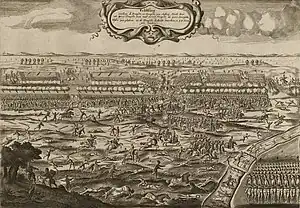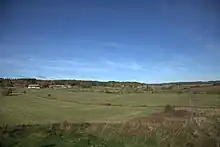| Battle of Axtorna | |||||||
|---|---|---|---|---|---|---|---|
| Part of Northern Seven Years' War | |||||||
 Old danish propaganda image of the battle | |||||||
| |||||||
| Belligerents | |||||||
|
|
| ||||||
| Commanders and leaders | |||||||
| Jakob Henriksson Hästesko | Daniel Rantzau | ||||||
| Strength | |||||||
|
8,100 infantry 3,000 cavalry 47 artillery pieces |
6,000 infantry 1,400 cavalry 21 artillery pieces | ||||||
| Casualties and losses | |||||||
| 1,200–1,700 | 300–2,500 | ||||||

The Battle of Axtorna or simply Axtorna, was a battle fought between the Kingdom of Sweden and Denmark-Norway 20 October 1565 at Axtorna, a small village in what is today Falkenberg Municipality, Halland County in south-western Sweden.
Background
The battle
The Danish commander Daniel Rantzau had been forced to yield the fortress Varberghus to the Swedes on 15 September 1565, after they had taken Ny Varberg, then Halland's largest city. Rantzau received the news that a Swedish army of superior strength led by Jacob Henriksson Hästesko was approaching from the east, forcing him to move his forces toward Falkenberg. Rantzau had decided to commit to combat since the Swedish force had just arrived from its march and hadn't rearranged into a militarily cohesive unit.
Aftermath
The Danes won as a consequence of their superior cavalry tactic[1] and Rantzau became a renowned general after the battle and throughout the war. Despite the victory and the capture of the Swedish artillery, the Danish had suffered great losses and stayed near the battlefield for a week, while large portions of the Swedish army were intact.
References
- ↑ Svenska Slagfält: "Axtorna 1565: En fråga om kavalleritaktik" (2003) pp. 69-76